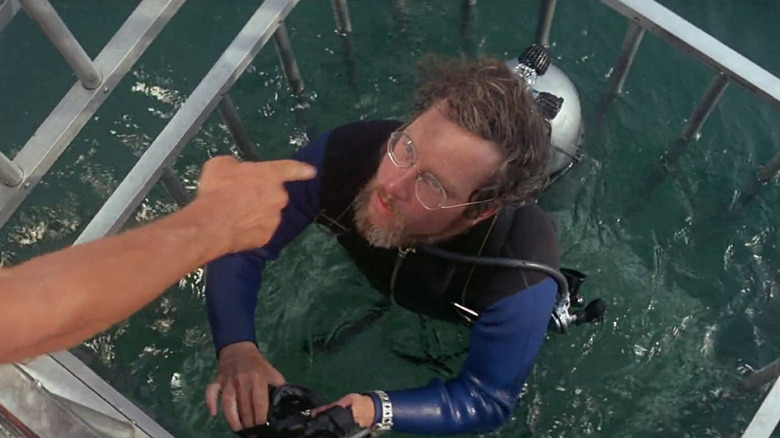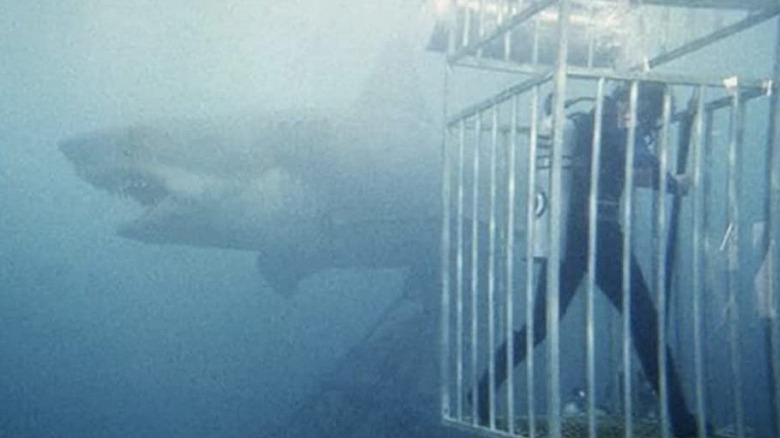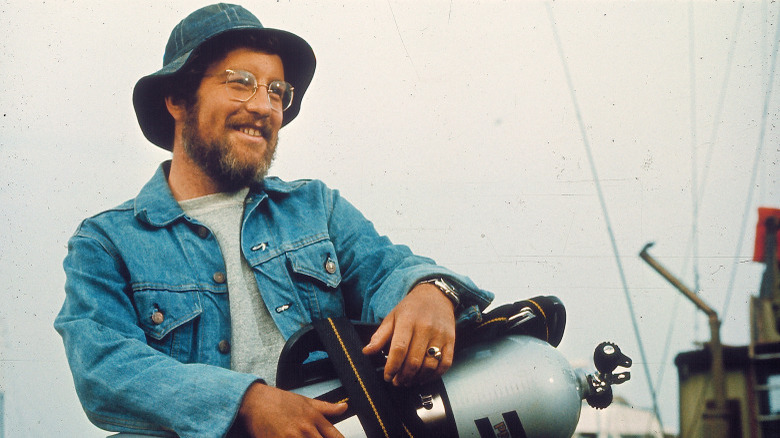The Cage Scene In Jaws Was More Real Than You Think
Going on 50 years later, director Steven Spielberg's "Jaws" continues to reign supreme as the champion of sharksploitation films. It's a movie full of truly iconic scenes that tap into our elemental fear of the ocean and, more specifically, the unknown terrors potentially lurking beneath its tranquil surface. However, out of the many unsettling moments in the film, there may be none more terrifying than when lovable oceanographer Matt Hooper decides to bring the fight directly to the great white shark menacing the beaches of Amity Island by entering the water in a (theoretically) shark-proof metal cage.
What ensues is a downright petrifying scene in which the shark tears through the cage (much to the screaming Hooper's horror) and nearly rips him to shreds before getting tangled in the cage itself, giving Hooper the opening he needs to swim away and hide behind the seabed. As you would expect, part of this sequence was filmed in a water tank with a mechanical shark. But the part where the shark gets stuck in Hooper's cage and thrashes about? That was footage of a real-life shark captured by Australian shark experts Ron and Valerie Taylor in the ocean near Dangerous Reef in South Australia.
Valerie Taylor recounted the incident in an interview with InsideHook in 2021, explaining:
"The shark in the movie was supposed to be 25 feet long, and the sharks on the reef were closer to 15 or 16 feet long. So to keep the appearance right, we went out on a very small boat, built a smaller shark-proof cage, and hired a very short actor. We learned after the fact that he really didn't know how to dive, and was worried about being around the sharks. At that moment there were about three large great whites gliding around outside."
How a Happy Accident Changed the FIlm
Taylor then explained how things nearly went terribly wrong, only to work out far better than expected:
"We didn't want to force anyone into the cage, and it was good that we didn't, because suddenly a huge 16-foot great white got caught in the wench that was connected to the cage. The shark started thrashing around, the wench broke off the side of the abalone boat, and fell down into a frothing mess in the sea. The cage was destroyed — clearly not as shark-proof as we had thought.
"If that actor had been in the cage when this happened, he would have died. We were fortunate that he was so reluctant. We were even more fortunate that Ron was already in the water and filming. I had run across the boat to grab our other camera and started filming from above as well. It was some of the most incredible shark footage anyone had ever seen, so of course the studio was happy. "
Spielberg was equally pleased with the footage and wanted to include it in the finished movie. In order to do that, though, some changes had to be made to the film's story, which originally had Hooper getting eaten by the shark during their cage battle. Seeing as the cage was clearly empty in the shot of the real-life great white shark getting ensnared and trying to break loose, the scene was altered so that Hooper escapes by swimming out the top of the cage while the shark rips it apart. By the time he resurfaces, Amity police chief Martin Brody has finally killed the shark by shooting and blowing up a scuba tank he had tossed into its mouth earlier (paying off a prior scene where Hooper warns Brody about just how volatile the tanks are).
Why Hooper Originally Died
The idea to have the shark chow down on Hooper came straight from the source material by Peter Benchley, who also wrote the earlier script drafts for the film version of "Jaws." What's more, Benchley's novel featured a whole subplot that centered on Brody and Hooper being at odds and even clashing with one another during their shark hunt after Hooper meets up with Brody's wife Ellen (who had previously dated Hooper's older brother) at a motel earlier in the book, leading Brody to suspect the pair of having a tryst. Ultimately, Spielberg's adaptation left out that story thread entirely, which resulted in Brody and Hooper being on friendly terms for most of the movie. Instead, the tension was between Hooper and Quint: the seasoned working-class fisherman who Brody hires to kill the shark but doesn't take so well to Hooper (a younger man from a wealthy upbringing who values his scientific knowledge over Quint's experience) tagging along on their expedition.
Naturally, Hooper's cage fight with the shark in "Jaws" has begun to show its age over time. (If you study it closely, it's fairly easy to tell which shots depict a real great white shark and which ones feature a mechanical shark.) Even so, it remains a skillfully constructed sequence — and, if you're willing to suspend your disbelief enough, one that's just as scary today as it was back when audiences first saw it in 1975.


